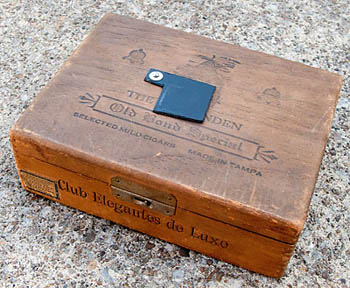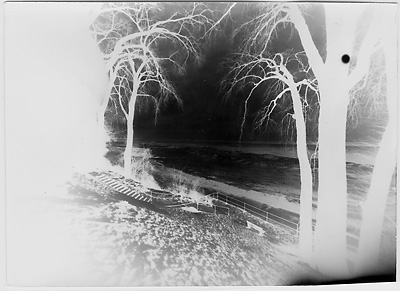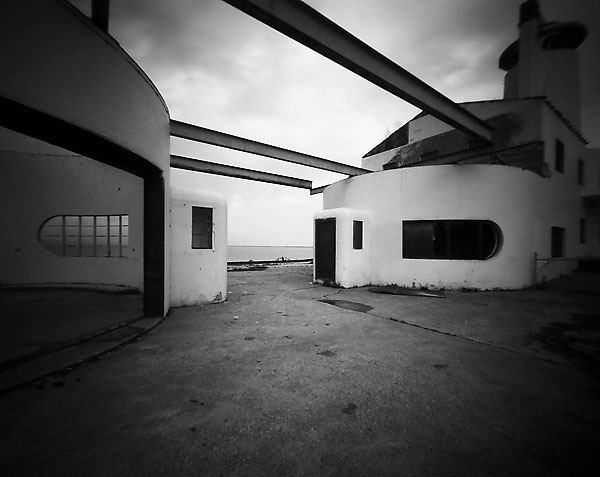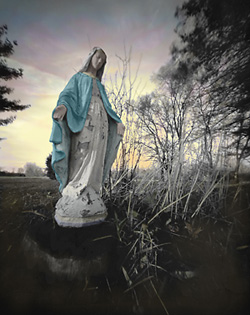About a year ago I started building pinhole cameras, experimenting with old cigar boxes.
My first camera is designed to accept a roll-film back made for Graflex-type cameras. That's still a work in progress, as I'm having trouble with the film back not working properly. More on that as it develops...
 The next project I tackled (shown here) was with a different style cigar box. This one has a 55mm focal length and instead of using film, it takes photo paper about 5 x 7 inches in size. I drilled a 1-inch hole in the middle of the top of the box. The aperture is made with a thin piece of copper and has a diameter of .0135 inches. I made the hole with the smallest micro drill I had. I know that it should be a little smaller than that for the focal length, but it's a baseline for me to work from.
The next project I tackled (shown here) was with a different style cigar box. This one has a 55mm focal length and instead of using film, it takes photo paper about 5 x 7 inches in size. I drilled a 1-inch hole in the middle of the top of the box. The aperture is made with a thin piece of copper and has a diameter of .0135 inches. I made the hole with the smallest micro drill I had. I know that it should be a little smaller than that for the focal length, but it's a baseline for me to work from.
The shutter is cut from a piece of plastic, actually an old mud flap for a car, fastened with a simple machine screw and nut.  Inside the camera, I put two slightly raised strips of plastic at each end of the bottom so the paper could be inserted under the lip to hold it in place.
Inside the camera, I put two slightly raised strips of plastic at each end of the bottom so the paper could be inserted under the lip to hold it in place.
Why I decided to test it on one of the colder days of winter I have no idea. I have an old changing bag I purchased at an estate sale so I could make multiple exposures in the field. I wasn't very picky about the location. I just wanted a good place to work. In this case I had an iron railing to brace the box against, and a bench to set the changing bag on.
So I would load a piece of paper in the bag, take it out of the bag, make the exposure, put it back in the bag, close it, take out the paper and put in a new sheet, repeat. Unfortunately, the paper I cut wasn't uniform so it wasn't always a tight fit.
I made exposures of 2, 4, 8, 16, 32 and 64 seconds as a test. By the third exposure my fingers were so cold I couldn't feel which was the light-sensitive side of the paper. But I guessed correctly since they were all arranged facing the same way.
 Back home, I set up a makeshift darkroom and processed the paper. It turned out that 2 to 4 seconds was about right for this overcast day. I expected it to be longer, but then again I had no idea of the real exposure value of the paper.
Back home, I set up a makeshift darkroom and processed the paper. It turned out that 2 to 4 seconds was about right for this overcast day. I expected it to be longer, but then again I had no idea of the real exposure value of the paper.
I picked the most properly exposed negative and made a contact print while it was still wet. The results were not great, but better than I expected. There is a bright spot toward one of the upper corners, caused by a hole in the top of the box that I had overlooked. There was either a little light leak in one corner, or it was caused by improper handling of the paper.
It's not a great photo, but it was terrific fun and a great learning experience. My ultimate goal is to be able to build reliable cameras that others can use, whether from found objects or built from scratch. Baby steps.
 Cigar box prototype #2. 4 seconds on paper at Huntington Reservation of the Cleveland Metroparks in Bay VIllage, OH.
Cigar box prototype #2. 4 seconds on paper at Huntington Reservation of the Cleveland Metroparks in Bay VIllage, OH.











